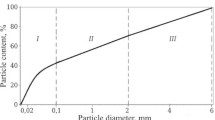Corundum composition heat insulating materials are used successfully for high-temperature insulation and are mainly produced by casting that has a number of disadvantages. The authors of the present article propose a vibration-compaction method for producing such materials that makes it possible to intensify the production process. Results are provided for a study of the compositions for preparing corundum heat-insulation materials based on hydraulic binders. The main features are established for the effect of charge component content on specimen physicomechanical properties. Optimum compositions are revealed satisfying the specifications of GOST 5040–2015.



Similar content being viewed by others
References
Yu. P. Gorlov, A. P. Merkin, and A. A. Ustenko, Heat Insulation Technology [in Russian], Stroiizdat, Moscow (1980).
K. É. Goryainov and S. K. Goryainova, Heat Insulation Materials and Object Technology [in Russian], Stroiizdat, Moscow (1982).
G. V. Voronov and V. A. Startsev, Refractory Materials and Objects in Industrial Furnaces and Subsidiary Equipment [in Russian], UGTU UPI, Ekaterinburg (2006).
T. A. Varennikova, V. A. Doroganov, and M. A. Smirnova, “Corundum lightweight refractories based on hydraulic binders,” Vestn. BGTI im V. G. Shukova, No. 5, 64 – 69 (2017).
N. T. Andrianov, V. L. Barkevich, A. V. Belyakov, et al., Ceramic Chemical Technology [in Russian], RIF Stroimaterialy, Moscow (2012).
N. A. Peretokina and V. A. Doroganov, “Development and study of the compositions of unshaped fireclay-based heat-insulating refractories and a technology for making them,” Refract. Indust. Ceram., 52(1), 52 – 54 (2011).
N. A. Peretokina and V. A. Doroganov, “Lightweight foam products based on diatomite,” Refract. Indust. Ceram., 52(3), 191 – 194 (2011).
E. I. Evtushenko, N. A. Peretokina, V. A. Doroganov, et al., “Heat insulation materials based on artificial ceramic binders if different composition,” Vestn. BGTI im V. G. Shukova, No. 6, 149 – 151 (2013).
I. D. Kashcheev, K. K. Strelov, and P. S. Mamykin, Refractory Chemical technology [in Russian], Intermet Inzhiniring, Moscow (2007).
M. A. Lur’e and V. P. Goncharenko, Lightweight Refractories in Industrial Furnaces [in Russian], Metallurgiya, Moscow (1974).
Work was performed within the scope of a program for developing the refractory university based at the V. G. Shukhov BGTU.
Author information
Authors and Affiliations
Additional information
Translated from Novye Ogneupory, No. 3, pp. 34 – 37, March, 2018.
Rights and permissions
About this article
Cite this article
Varenikova, T.A., Gokova, E.N., Doroganov, V.A. et al. High-Alumina Heat-Insulating Materials Based on a Hydraulic Binder. Refract Ind Ceram 59, 140–143 (2018). https://doi.org/10.1007/s11148-018-0195-3
Received:
Published:
Issue Date:
DOI: https://doi.org/10.1007/s11148-018-0195-3




